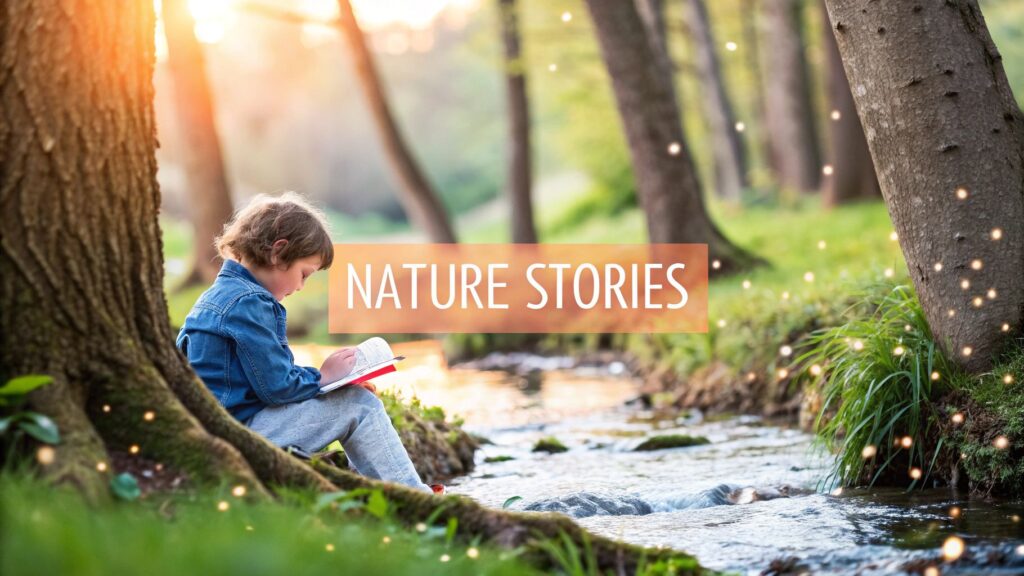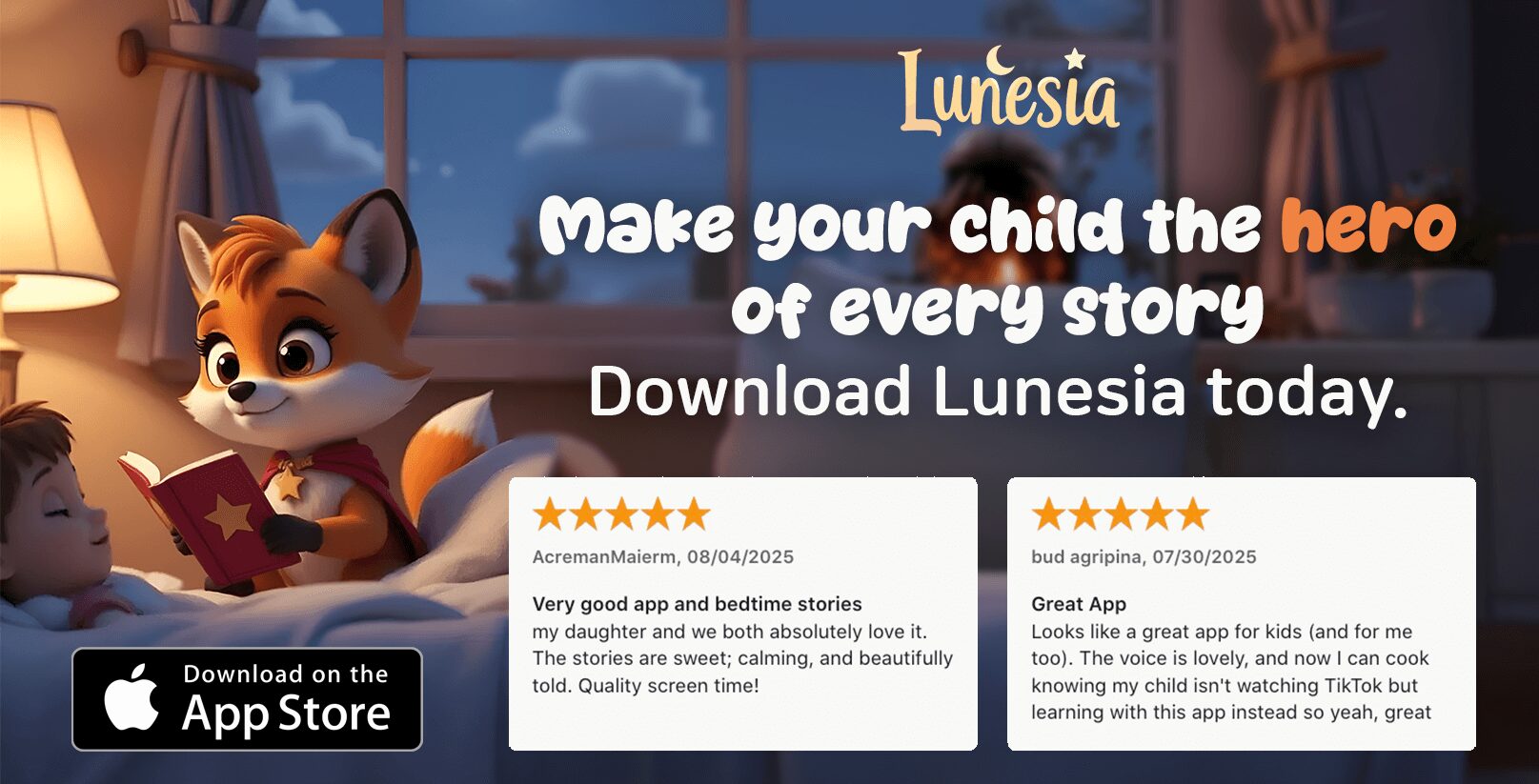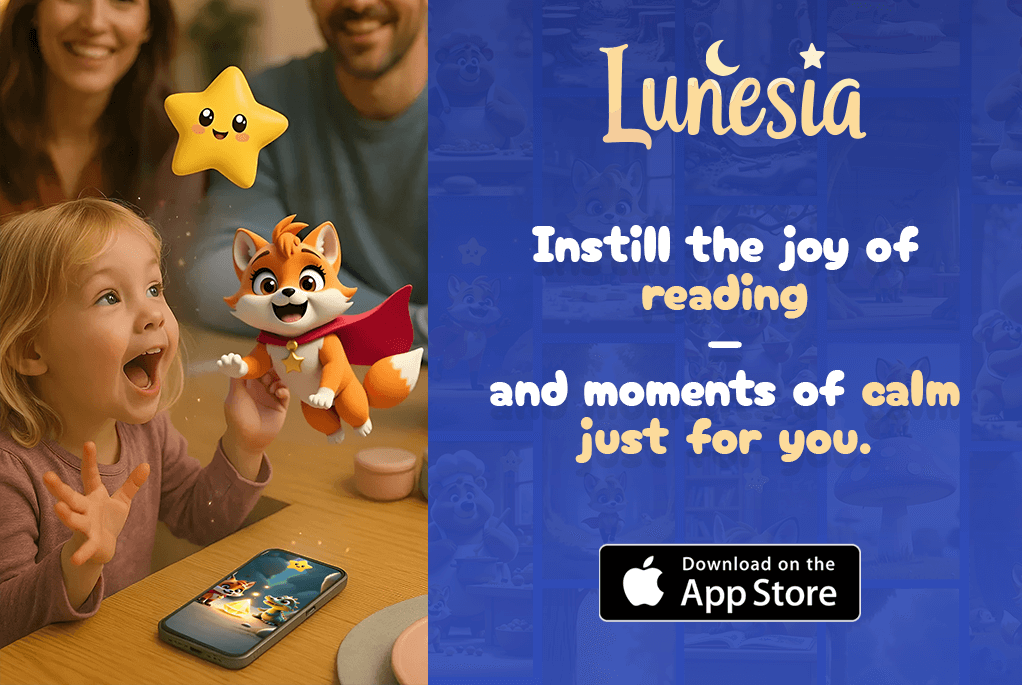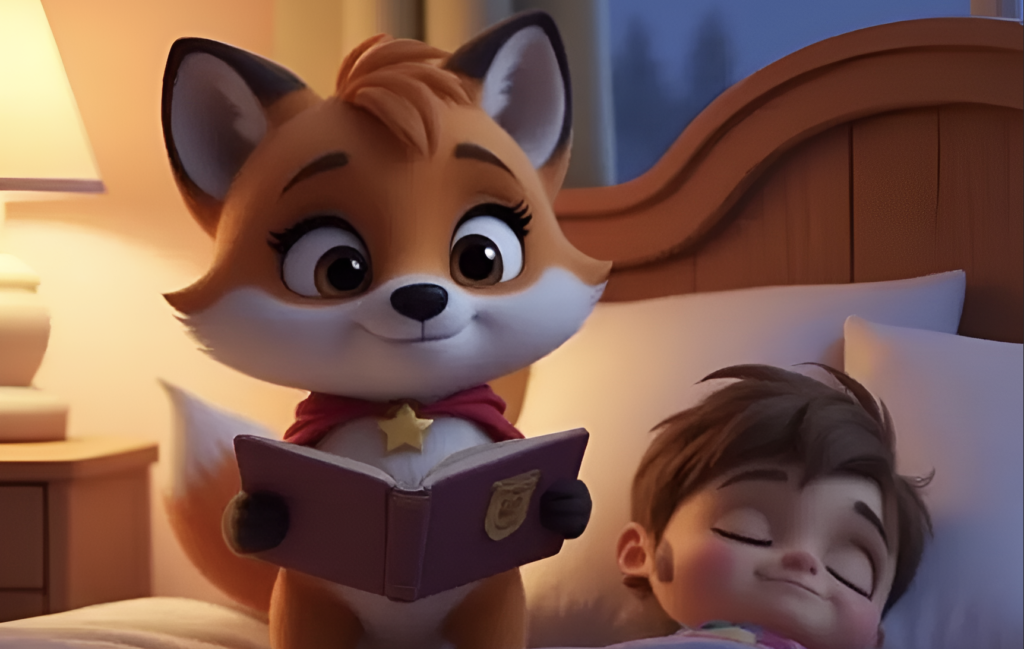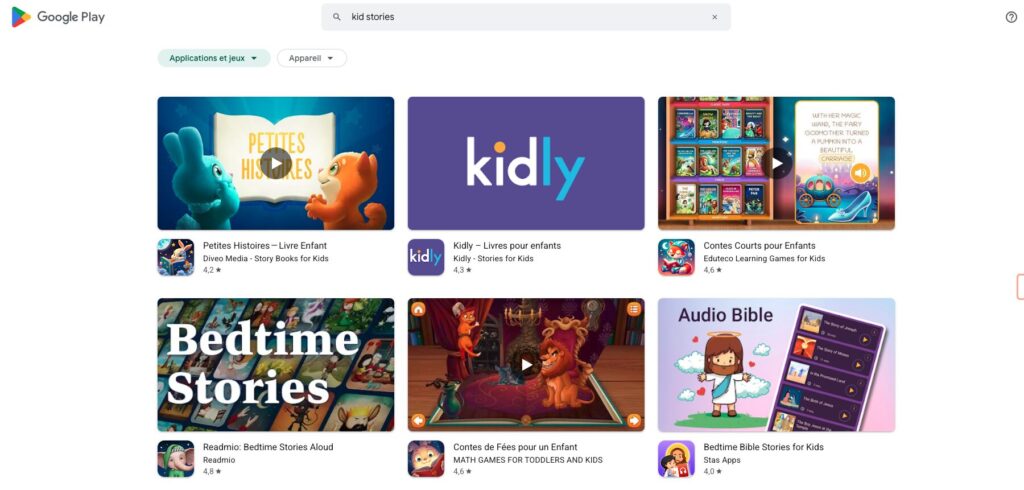Ever wonder if there's a better way to navigate those tricky toddler meltdowns or preschooler fears? What if the answer wasn't in another parenting book, but hidden within the rustling leaves of a forest or the whisper of a river? This is where the magic of powerful storytelling comes in, and we’ve curated seven incredible stories about nature that do more than just entertain. These tales are secret gateways to building courage, empathy, and resilience in your little one, aged 2 to 7.
We'll explore how the right story at the right time can transform daily challenges into meaningful growth. Imagine turning a tantrum over a broken toy into a lesson on problem-solving, or soothing bedtime anxieties by exploring a character's bravery. These stories provide the perfect springboard for those conversations.
But what if your child could be the hero in these adventures? We’ll also show how innovative tools, like the Lunesia app, are revolutionizing storytime. They turn passive listening into active participation, letting kids make choices that shape the outcome. By the end of this list, you’ll have a powerful toolkit for nurturing a brave, kind, and curious child, all while reclaiming a few peaceful, guilt-free moments for yourself.
1. Watership Down by Richard Adams
Have you ever wondered what the world looks like from a rabbit’s point of view? Richard Adams’ classic, Watership Down, isn't just one of the most famous stories about nature; it’s an epic adventure that explores courage, leadership, and the profound connection between animals and their environment. It follows a band of brave rabbits who flee their doomed warren, using their wits and natural instincts to find a new, safe home.
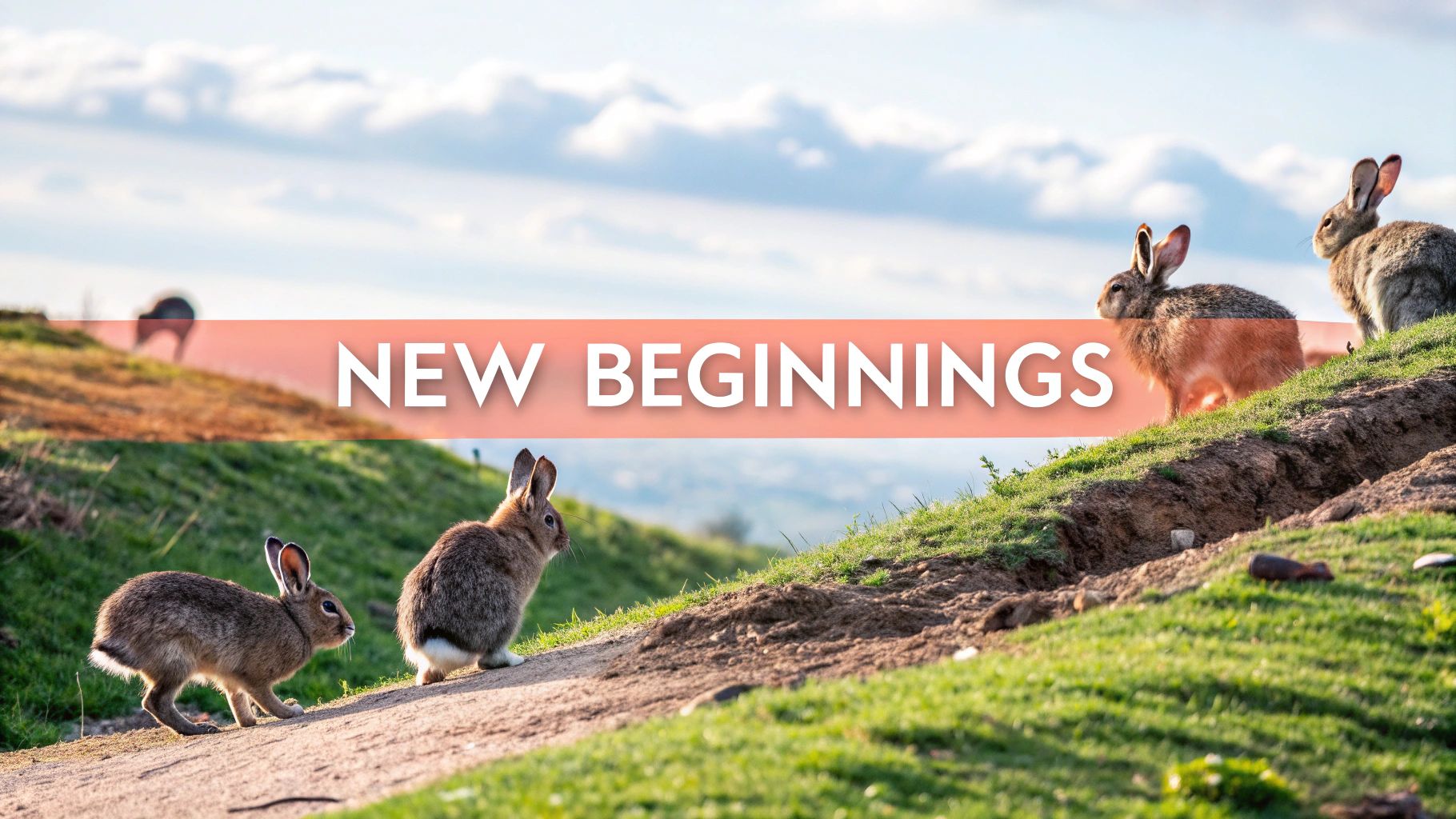
While the original novel is complex and best suited for older readers, its themes are powerful. The story is a fantastic springboard for conversations about community and problem-solving, even with younger children. The rabbits in the story don't just hop around; they make tough decisions, face their fears, and work together to overcome incredible odds. This mirrors the kind of resilience and empathy we want to nurture in our own kids.
Why This Story Is a Nature Classic
What if a story could teach your child about bravery and ecology at the same time? Watership Down brilliantly blends thrilling adventure with authentic animal behavior.
- Environmental Awareness: It introduces concepts like habitat loss and human impact in a way that’s accessible. You're not just reading a story; you're seeing the world through the eyes of its most vulnerable inhabitants.
- Problem-Solving: The rabbits, led by the clever Hazel, must constantly adapt and think on their feet. This shows children that challenges can be overcome with teamwork and smart thinking.
- Emotional Depth: The story dives into themes of loyalty, sacrifice, and hope, helping children build emotional literacy.
Parenting Insight: Discussing the rabbits' fears and triumphs can help your child articulate their own big feelings, building emotional resilience. Research shows that stories centered on overcoming adversity can improve a child's own coping skills.
Making It Age-Appropriate and Interactive
How can you bring such a big story to a younger audience? The key is to adapt it. You can summarize the plot, focusing on the journey and the teamwork. Better yet, look for beautifully illustrated picture book versions or short animated clips that capture the spirit of the adventure without the novel's more intense scenes.
Interactive platforms like the Lunesia app offer a similar spirit of adventure, but designed specifically for young minds. In Lunesia’s interactive stories, your child isn't just a listener; they are the hero. They make choices that shape the narrative, learning firsthand about cause and effect, empathy, and problem-solving in a safe, ad-free digital environment. It’s like being Hazel on his quest, but with your child in the driver’s seat. This gives you precious moments of guilt-free time while your child is engaged in a meaningful, skill-building activity.
2. The Call of the Wild by Jack London
Could your child learn about resilience from a dog’s epic journey? Jack London's The Call of the Wild is one of the most powerful stories about nature ever written. It plunges readers into the life of Buck, a domesticated dog who is stolen from his comfortable home and forced to survive as a sled dog in the harsh Alaskan wilderness. It's a gripping tale of survival, instinct, and the untamed spirit within us all.

While the full novella is for older audiences, its core message about adapting to challenges is timeless and can be simplified for younger children. Buck's journey from a pampered pet to a capable leader is a profound lesson in inner strength and finding your place in the world. It’s an ideal story to spark conversations about perseverance and facing the unknown, helping kids understand that they too can be brave when things get tough.
Why This Story Is a Nature Classic
How can a story from over a century ago teach modern lessons about grit? The Call of the Wild connects thrilling adventure with deep, instinctual truths about the natural world.
- Adaptability and Resilience: Buck’s transformation highlights how challenges make us stronger. This shows children that adapting to new situations is a powerful skill.
- Connection to Nature: The story fosters a deep respect for the wild, exploring the raw beauty and unforgiving reality of nature. It’s a lesson in both awe and caution.
- Understanding Instinct: It explores the idea that we all have a "wild" or instinctual side, helping kids understand their own feelings and impulses in a new way.
Parenting Insight: Discussing how Buck listens to his instincts can help your child learn to trust their own gut feelings. This builds self-confidence and empowers them to navigate social situations with more assurance, a skill supported by child development research.
Making It Age-Appropriate and Interactive
How do you introduce such a rugged story to a 5-year-old? Focus on the adventure and Buck’s courage. Simplified picture book versions and animated adaptations are perfect for capturing the essence of the story without its more brutal elements. You can also explore the historical Klondike Gold Rush to give context. If the story sparks an interest in helping animals, you can even look into local wildlife conservation volunteer opportunities to make the connection real.
For a modern, interactive take on adventure, the Lunesia app offers stories where your child directs the action. Instead of just hearing about Buck's journey, they can lead their own quests, making choices that teach them about consequences and empathy. It’s a guilt-free way for you to get a few minutes to yourself, knowing your child is engaged in a story that builds the same kind of resilience and problem-solving skills found in classic tales like The Call of the Wild.
3. My Side of the Mountain by Jean Craighead George
Could your child thrive in the wilderness? Jean Craighead George’s beloved classic, My Side of the Mountain, explores this very question. It’s one of those essential stories about nature that goes beyond mere appreciation, diving deep into self-reliance, ingenuity, and a profound respect for the wild. The story follows young Sam Gribley, who leaves city life behind to live off the land in the Catskill Mountains, learning to build a home, find food, and befriend the local wildlife.
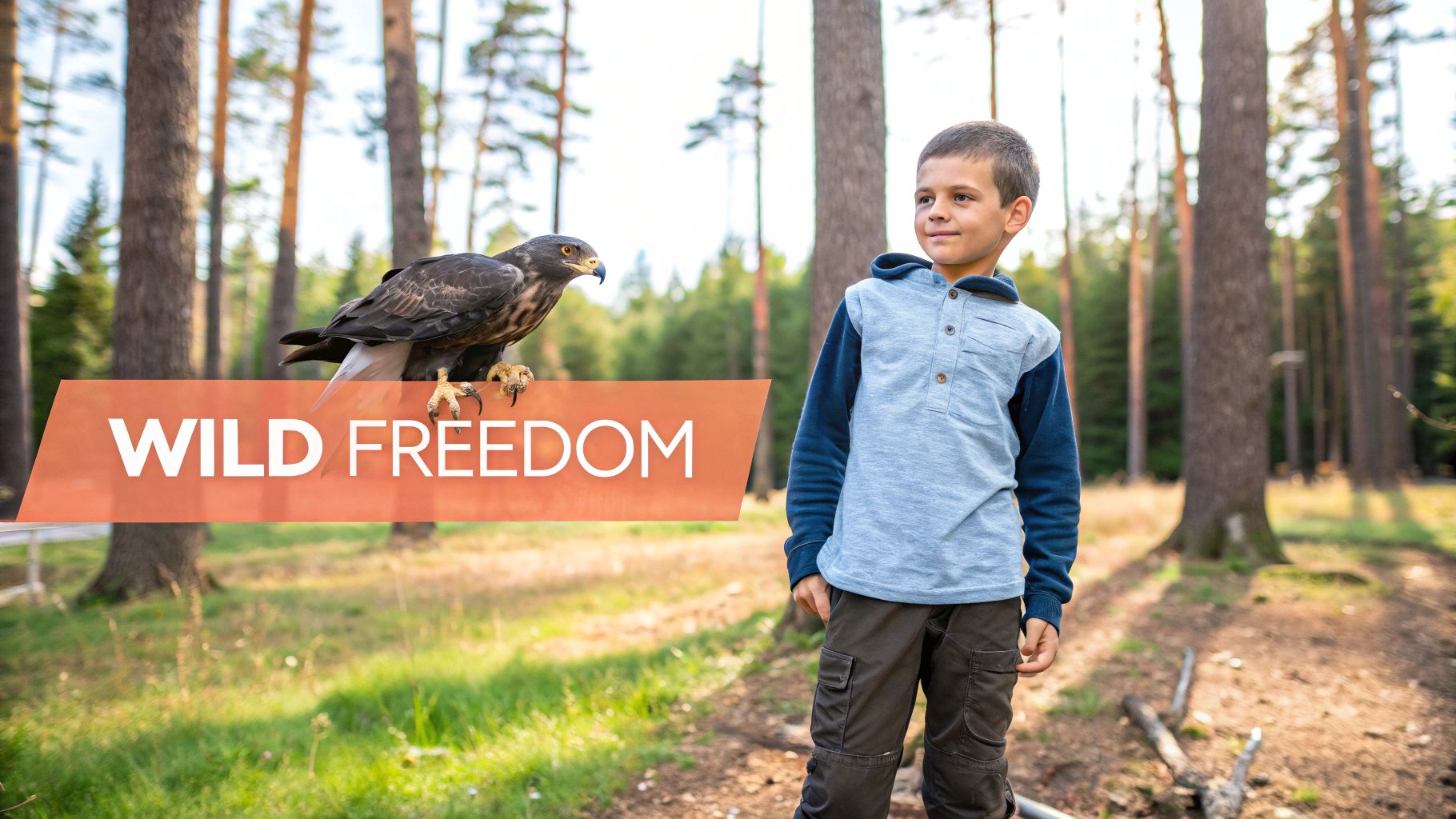
While the full novel is for older children, its core message is a powerful inspiration for all ages. It champions curiosity, resilience, and the idea that we are capable of far more than we imagine. The story shows how challenges, like building a shelter or training a falcon, become opportunities for growth, teaching children that resourcefulness and patience are their greatest tools.
Why This Story Is a Nature Classic
What if a book could ignite a lifelong passion for the outdoors? My Side of the Mountain is a masterclass in making nature an active, engaging character.
- Promotes Self-Reliance: Sam’s journey is a powerful lesson in problem-solving and independence. It shows kids that they can learn new skills and overcome obstacles on their own.
- Deepens Environmental Connection: The story details how Sam lives in harmony with his environment, not just in it. This nurtures a deep respect for ecosystems and wildlife.
- Sparks Scientific Curiosity: From identifying edible plants to understanding animal behavior, the book is filled with practical knowledge that encourages children to observe and learn about the world around them.
Parenting Insight: Use Sam's adventures as a jumping-off point to discuss resourcefulness in daily life. When your child faces a problem, ask, "What would Sam do?" This prompts them to think creatively instead of immediately asking for help.
Making It Age-Appropriate and Interactive
How do you adapt a survival story for a five-year-old? Focus on the wonder, not the hardship. Read excerpts about Sam’s friendship with his falcon, Frightful, or describe how he made his treehouse home. You can even start a small container garden or build a backyard "shelter" to bring his skills to life, always with adult supervision.
For a safer, digital-first approach, the Lunesia app captures this same spirit of independence and discovery. In Lunesia’s stories, children step into the shoes of the main character, making choices that directly impact the outcome. They learn to think critically and solve problems, just like Sam, but within a framework designed for their age. Explore how to build these skills through a guided narrative with Lunesia’s interactive storytelling techniques for your child. It provides a perfect, guilt-free way for your child to build confidence and creativity while you get a much-needed break.
4. The Yearling by Marjorie Kinnan Rawlings
What happens when a child’s love for a wild animal clashes with the harsh realities of life? Marjorie Kinnan Rawlings' Pulitzer Prize-winning classic, The Yearling, is one of the most poignant stories about nature ever written. It follows a young boy named Jody who adopts an orphaned fawn, Flag, in the rugged Florida frontier, exploring their deep bond and the painful lessons of growing up.
While the novel deals with mature themes, its core story of love, responsibility, and loss is a powerful foundation for discussions with children. The story masterfully portrays the delicate balance between humans and the natural world, showing how our choices impact the creatures we share our planet with. It opens a door to conversations about empathy and making difficult decisions, even when it hurts.
Why This Story Is a Nature Classic
Could a story from nearly a century ago teach your child about modern conservation? The Yearling remains a timeless classic because it so beautifully captures the complexities of our relationship with nature.
- Emotional Responsibility: The story doesn't shy away from the hard truth that loving an animal means being responsible for it, teaching a profound lesson in accountability.
- Understanding Ecosystems: It vividly depicts the unique Florida scrublands and the delicate balance of its ecosystem, showing how every living thing has a role to play.
- Human-Wildlife Connection: Jody’s bond with Flag highlights the deep connection we can form with animals, fostering empathy and respect for wildlife.
Parenting Insight: The story's bittersweet ending provides a safe space to talk about difficult emotions like loss and responsibility. Studies show that exploring complex feelings through stories helps children develop stronger emotional regulation and empathy.
Making It Age-Appropriate and Interactive
How do you introduce such a profound story to a young child? Focus on simplified versions, like illustrated children’s editions or clips from the classic film adaptation, that highlight Jody and Flag’s friendship. You can discuss the story’s central theme: that loving nature sometimes means making tough choices to protect it.
For a more hands-on approach, storytelling apps like Lunesia allow your child to step directly into similar dilemmas. In Lunesia’s interactive adventures, children make choices that impact the story's outcome, learning about responsibility and consequences in a supportive environment. They might have to decide how to help a lost animal or protect a forest, actively building the problem-solving and empathetic skills that The Yearling champions. This transforms passive storytime into an active learning experience, giving you guilt-free time while your child becomes a thoughtful, compassionate hero.
5. Island of the Blue Dolphins by Scott O'Dell
What if your child could learn about resilience and ecology from one of history’s most powerful survival stories? Scott O'Dell's Island of the Blue Dolphins is more than just one of the classic stories about nature; it’s an unforgettable tale of courage, self-reliance, and a deep, respectful connection to the wild. Based on the true story of a Native American girl stranded alone on a remote island for 18 years, it follows Karana as she learns to survive using her wits and the resources of the land.

While the full novel is for older readers, its core message of determination is perfect for introducing to younger children. Karana’s story is a brilliant entry point for discussing indigenous knowledge, sustainable living, and the incredible strength we can find within ourselves. She doesn't just survive; she builds a life, forming bonds with animals and learning to live in harmony with her environment. This narrative powerfully showcases the importance of respecting nature and valuing different ways of life, a theme you can explore further with other stories that introduce diverse experiences.
Why This Story Is a Nature Classic
Could a 19th-century survival story teach modern lessons in sustainability? Island of the Blue Dolphins beautifully connects adventure with profound respect for the natural world.
- Environmental Harmony: Karana’s journey teaches children about ecosystems and sustainable resource management. She takes only what she needs, showing a deep respect for the island's balance.
- Problem-Solving Skills: From building shelter to finding food, Karana’s every action is a masterclass in creative problem-solving and perseverance.
- Emotional Resilience: The story explores loneliness, courage, and the importance of companionship, helping children understand and name their own complex feelings.
Parenting Insight: Discussing how Karana overcomes her loneliness and fear can empower your child to face their own anxieties. Studies show that narratives of resilience help children develop their own coping mechanisms and a "can-do" attitude when faced with challenges.
Making It Age-Appropriate and Interactive
How do you adapt such a layered story for a 3- to 7-year-old? The key is to focus on the spirit of Karana's ingenuity and connection with nature. You can find simplified picture-book versions or retell her story, emphasizing her friendship with the animals and her clever solutions to everyday problems.
For an even more immersive experience, the Lunesia app puts your child directly into nature-based adventures where they are the hero. In Lunesia’s interactive tales, children make choices that determine the outcome, learning about cause and effect, empathy, and environmental stewardship firsthand. Imagine your child deciding how to help a lost animal or what to build for shelter; it’s like stepping into Karana’s world, but in a safe, ad-free space designed for them. This gives you guilt-free time while your child is actively building the resilience and problem-solving skills celebrated in this timeless story.
6. Hatchet by Gary Paulsen
What if your child could learn true resilience from one of the greatest survival stories ever told? Gary Paulsen’s Hatchet is a modern classic that follows 13-year-old Brian, who must survive alone in the wilderness after a plane crash with nothing but a small hatchet. While the novel is for older kids, its powerful story of grit and ingenuity offers incredible lessons for even the youngest children.
The core of Hatchet is about seeing challenges not as scary obstacles, but as opportunities to learn and grow. Brian starts with no skills but learns to make fire, find food, and build shelter by observing nature and trying again after every failure. This powerful message of perseverance is a fantastic foundation for teaching our own children not to give up when things get tough.
Why This Story Is a Nature Classic
How can a story about survival teach a preschooler about confidence? Hatchet’s themes are universal, brilliantly showing how understanding nature leads to self-reliance.
- Radical Problem-Solving: The story is a masterclass in creative thinking. It shows that with observation and patience, you can solve almost any problem using the resources around you.
- Building True Resilience: Brian's journey is one of immense emotional and mental growth. He learns to manage fear and find hope, modeling the kind of emotional regulation we want to foster in our children.
- Deep Respect for Nature: Brian doesn't conquer nature; he learns to live in harmony with it. This fosters a deep appreciation for the environment as a provider and teacher.
Parenting Insight: Discussing how Brian learned from his "mistakes" can help your child see their own errors as learning opportunities, not failures. Studies in child psychology show that a "growth mindset" is a key predictor of future success and happiness.
Making It Age-Appropriate and Interactive
You wouldn’t read the full novel to a five-year-old, but you can absolutely bring its spirit to life. Simplify the plot: "Imagine a boy who got lost in the woods and had to learn to build his own house and find his own snacks!" Use it as a launchpad for a backyard "survival" game where you find different types of leaves or build a tiny stick shelter.
For a ready-made digital adventure that captures this same spirit of self-reliance, the Lunesia app is a perfect fit. In Lunesia’s interactive stories, your child steps into the role of the hero, making choices that directly impact the outcome. They might have to decide how to help a forest creature or what to build to cross a stream. This active participation teaches problem-solving and resilience in a way that’s perfectly tailored for young minds, giving you guilt-free time while they build real-world skills in a safe, ad-free world.
7. Where the Red Fern Grows by Wilson Rawls
Can a story about a boy and his dogs teach your child about perseverance and the profound bond between humans and animals? Wilson Rawls' Where the Red Fern Grows is a timeless American classic that plunges readers into the heart of the Ozark Mountains. It's an unforgettable journey following a young boy, Billy, who works tirelessly to buy and train two hunting hounds, creating a powerful story about nature, dedication, and love.
While the novel is a deeply emotional read for older children, its core message about setting a goal and working for it is universal. The story is a wonderful foundation for discussing topics like responsibility, the human-animal connection, and the bittersweet cycles of life. Billy's unwavering commitment to his dogs, Old Dan and Little Ann, models the kind of passion and loyalty we hope to inspire in our own children.
Why This Story Is a Nature Classic
How can one boy's dream resonate so deeply with generations of readers? Where the Red Fern Grows is more than just an adventure; it's a lesson in heart and grit, set against a rich natural backdrop.
- Teaches Perseverance: Billy’s determination to earn his dogs is a powerful example of hard work and delayed gratification. It shows children that achieving a dream takes patience and effort.
- Deep Human-Animal Bond: The story beautifully illustrates the powerful, symbiotic relationship between humans and working animals, fostering empathy and respect for other creatures.
- Cultural and Ecological Context: It offers a window into life in the rural Ozarks, introducing children to a unique ecosystem and a historical way of life deeply connected to the land.
Parenting Insight: The story's emotional depth, including its sad moments, can be a safe space to discuss loss and grief with your child. Studies confirm that bibliotherapy, or using stories to navigate tough emotions, helps children develop crucial coping mechanisms.
Making It Age-Appropriate and Interactive
How do you introduce such a mature story to a young child? The key is to focus on the themes of love and adventure. You can narrate a simplified version of Billy’s quest to get his puppies and their fun adventures in the woods. Look for illustrated summaries or animated adaptations that capture the story's spirit without its more heartbreaking elements.
For a more direct, hands-on experience in building empathy and perseverance, interactive platforms like the Lunesia app are ideal. In Lunesia’s adventures, your child steps into the hero’s shoes, making choices that teach them about responsibility and the consequences of their actions. They might help a lost forest creature or work with others to solve a problem, learning the same lessons of dedication found in classic stories about nature. This turns screen time into a powerful tool for character-building, giving you a guilt-free break while they grow.
Nature Story Comparison Matrix
| Title | Implementation Complexity 🔄 | Resource Requirements ⚡ | Expected Outcomes 📊 | Ideal Use Cases 💡 | Key Advantages ⭐ |
|---|---|---|---|---|---|
| Watership Down | Moderate – complex rabbit culture and mythology | Moderate – requires supplementary guides | High – environmental awareness and social themes | Environmental education, literature for mixed ages | Rich world-building, educational on ecology |
| The Call of the Wild | Moderate – historical context and animal behavior | Low – accessible length and background research | High – understanding wilderness survival | Wilderness education, historical literature curricula | Strong survival theme, psychological insight |
| My Side of the Mountain | Moderate – detailed survival skills described | Moderate – best with guided outdoor activities | High – promotes self-reliance and nature respect | Outdoor education, survival skills training | Scientifically accurate nature info |
| The Yearling | Moderate – historical and ecological complexity | Low to moderate | Moderate – emotional depth and historical knowledge | Environmental and historical education | Strong character development, ecosystem portrayal |
| Island of the Blue Dolphins | Moderate – focus on indigenous knowledge and survival | Moderate – background on ecosystems recommended | High – sustainability and cultural awareness | Marine biology education, indigenous studies | Highlights indigenous environmental knowledge |
| Hatchet | Moderate – practical survival techniques | Moderate to high – needs training for safety | High – wilderness survival and mental resilience | Wilderness safety education, youth survival training | Realistic survival skills, builds perseverance |
| Where the Red Fern Grows | Moderate – rural culture and hunting skills | Low – familiar rural settings | Moderate – dedication, cultural education | Rural/agricultural education, literature on human-animal bond | Emotional depth, teaches perseverance and dedication |
Your Next Adventure Awaits: Give Your Child the Gift of Choice (and Yourself the Gift of Time)
We've journeyed through timeless classics, from the harrowing adventures in Watership Down to the quiet resilience of Karana in Island of the Blue Dolphins. Each of these stories about nature offers a window into a world of courage, survival, and deep connection to the environment. They remind us that nature isn't just a backdrop; it’s a powerful teacher, a source of wonder, and a reflection of our own inner strengths. These tales equip our children with vicarious experiences, planting seeds of empathy and bravery that will blossom for years to come.
But what if your child could do more than just listen? What if they could step into the story and make choices that mattered?
From Passive Listener to Active Hero
The true power of storytelling is unlocked when a child sees themselves as the hero, not just as an observer. When they are faced with a challenge, like helping a lost animal or deciding how to cross a rushing river, they aren't just hearing about problem-solving; they are actively practicing it. This is where the magic of interactive storytelling comes in.
Imagine a story where your child doesn't just read about a character's fear of the dark but helps a little firefly find its courage by choosing the bravest path. Studies, including compelling research from the University of Sussex, have shown that interactive narratives can boost a child's perspective-taking and empathy skills by over 30%. They learn to see the world through others' eyes, a foundational skill for emotional intelligence.
Key Takeaway: Shifting from passive reading to active participation transforms storytime into a powerful developmental tool. It builds critical thinking, empathy, and the confidence that comes from seeing their decisions create positive outcomes.
Practical Steps to Foster an Interactive Mindset
Empowering your child through stories doesn't stop with the book. You can bring this spirit of choice and creativity into your daily reading rituals. Here are a few actionable ways to start today:
- Pause and Ponder: When reading any book, pause at a key moment and ask, "What would you do here?" This simple question turns any story into an interactive experience.
- Create Alternate Endings: After finishing a story, brainstorm different outcomes together. What if the character made a different choice? This encourages creative thinking and shows that there's often more than one way to solve a problem.
- Bring the Story to Life: Encourage your child to draw their favorite scenes or even create their own characters. For inspiration on how to get started, you can find a wealth of storybook illustration ideas that can spark their artistic confidence and deepen their connection to the narrative.
By embracing these small changes, you're not just reading stories about nature; you're cultivating a generation of thoughtful, resilient, and creative problem-solvers. You're giving them a safe space to practice life's big lessons, all while snuggled up beside you. And as they become absorbed in these empowering worlds, you gain something invaluable: a few moments of peace, free from guilt, knowing their screen time is growth time.
Ready to transform storytime into a personalized adventure that builds confidence and empathy? Discover the world of Lunesia, where your child directs the narrative, solves problems, and learns crucial life skills through engaging, ad-free stories. Download Lunesia today and watch your little one become the hero of their own tale.
